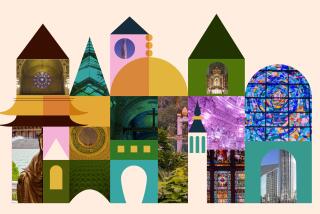Marble Palaces of Home Savings Remind Us What the Money’s for
- Share via
They are a fixture in the Southland: gold and white temples to all-American values like family, industry and, most especially, savings. They are the branches of the largest savings and loans institution in the country, Home Savings of America. These are not your standard bank buildings, but imposing travertine marble palaces adorned with stained glass, sculpture and mosaics that depict the ideal life to be had in Southern California. The marble box tells you that this is a safe, dependable place to store your money, while all of the art gives you a picture of what you are saving for.
One of the more typical branches of Home Savings can be found on the corner of Wilshire Boulevard and 26th Street in Santa Monica. Like most of the other branches, it was designed by Millard Sheets, the man who gave an image to H. F. Ahmanson’s vision of American savings. Sheets, who died two years ago at the age of 81, was actually not an architect. He was an accomplished watercolorist, painter and teacher who just happened to extend his vision into the realm of buildings.
Working with a studio of artist-collaborators and architects, he designed not only dozens of Home Savings branches, but major civic structures in places as far afield as Lubbock, Tex., and Hawaii. His library at the Claremont Colleges and the Scottish Rite Temple in Los Angeles are two of the most well-known local landmarks he designed. His strategy consisted of making big white boxes, minimal in their detail but imposing in their presence, and then using them as the scaffolding for an elaborate art program.
The Santa Monica branch is no exception. You can find one almost identical to it on the corner of Sunset Boulevard and Vine Street in Hollywood. They both sit on a diagonal, removing themselves from the grid-like regularity around them. Their travertine walls are ringed with a gold cornice and adorned with the bank’s name, but mainly they act as a backdrop for giant murals.
It is those murals that make the branches specific to their place. The one on the Santa Monica branch depicts the good life of the beach. The main facade is almost completely covered with this terrazzo vision of children playing, adults sunning and fishermen working. The plaza in front, which sets the stage for the relatively small but imposing building, is focused on a bronze sculpture fountain showing a family of four dancing around the spouts. Inside, the straightforward but high and narrow banking hall is steeped in quasi-religious hues produced by a stained-glass window that takes the family-at-the-beach theme into a swirling vortex of deep blue water and arching forms. The last touch in the art program is a bronze dolphin playing over the parking lot entrance in the back.
When this Home Savings was built in 1969, it may have looked like a tomb for the Silent Majority, and certainly the composition and goals of its clientele seem to have changed somewhat since then. This Home Savings remains powerfully out of step with the continually changing neighborhood, its forms denying the life around it and its pictures reinventing life as sunny myth. It cannot be ignored, which is more than you can say for most bank buildings, and it offers a surplus of art and architecture as a lasting contribution of Sheets’ and Ahmanson’s vision of Southern California.
More to Read
Inside the business of entertainment
The Wide Shot brings you news, analysis and insights on everything from streaming wars to production — and what it all means for the future.
You may occasionally receive promotional content from the Los Angeles Times.










